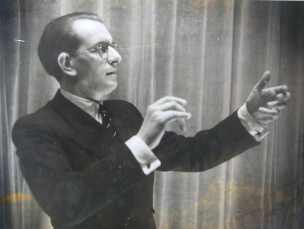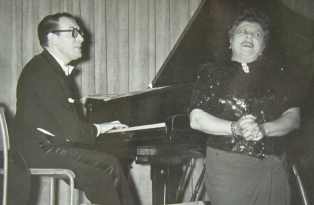Jan Broekhuis
(also known as: John Brookhouse McCarthy, Mac Carthy, Jan Broekhuis McCarthy)
Jan Broekhuis was born as Johannes Franciscus Broekhuis on 25 February 1901 in Amsterdam. His father was Johannes Franciscus „Jan“ Verhoeven, a professional musician. He was for example organist at the Elisabethskerk in Rotterdam as well as Kapellmeister at the Noggerath theatre and a member of the orchestra of Frans Ossenegg. So it is likely that Jan Broekhuis received a musical education from an early age.
After school Jan Broekhuis studied music at the conservatory in Amsterdam under Evert Cornelis, Egbert Veen and Julius Röntgen (piano), Jean-Baptiste de Pauw (organ), Bernard Pennarts (timpani), Frowein (violin) and Isaac Mossel (ensemble playing).
Around the year 1926 Jan Broekhuis must have finished his studies and it seems that he moved to France. He became teacher at music schools in Biarritz and Limoges and earned a living as a pianist and conductor at different concerts. This must be quite successful because in 1930 Jan Broekhuis became conductor at the famous Theatre Comoedia in Paris and around that time also at the Theatre des Celestins in Lyon. Beside his conducting career Jan Broekhuis also wrote articles for the journal „Jazz Tango“ at that time.
In the late 1920s Jan Broekhuis also teamed up with the tenor Charles Richard. The two artists performed under the name „Richard et Mac Carthy“ and recorded a few songs which were published by Brunswick Records in 1930. Richard et Mac Carthy entertained several times at the Empire Music-Hall in Paris the same year where they were announced as the „celebres vedettes du phonographe“.
Beside his activities as a conductor, pianist and entertainer Jan Broekhuis also wrote his own compositions since the 1920s. His first compositions date from his time at the conservatory in Amsterdam and his first published work seems to be the piano piece „Une valse a la Chopin“ which was printed by Seyffardt in Amsterdam in 1925. In general the early works by Jan Broekhuis were „classical“ pieces for piano or violin and piano. Around 1930 larger compositions, also with orchestra, songs and more unusual settings like saxophone and piano can be found in the output.
In the early 1930s Jan Broekhuis worked for the Dutch broadcasting service and used his compositional skills to create arrangement for shows. In 1933 he was also part of the film production of „De Jantjes“, one of the very first sound films in the Netherlands. For this film Jan Broekhuis was the music director, made arrangements of the used songs and added three own compositions. His songs „Omdat ik zoveel van je hou“ and „Draaien“ became very famous and are still well known in the Netherlands.
With the experience of sound film and film music Jan Broekhuis moved to the US already shortly after the release of „De Jantjes“ in 1934. In the following years he tried to establish ties with some large film music companies like Irving Berlin Music Inc, Robbins Music Inc. or Metro Goldwyn Mayer. The foreshadows of the upcoming war forced Jan Broekhuis to go back to the Netherlands in 1938.
Back in the Netherlands Jan Broekhuis mainly worked as a conductor. Already in 1938 he was part of the show „Dat is Holland!“ starring Heintje Davids. And also during World War II Jan Broekhuis could work as a conductor. He led for example performances of different operettas at the Tivoli in Amsterdam or assembled small orchestras and toured through the Netherlands and Germany.
After the war Jan Broekhuis continued his career as an operetta conductor and conductor of light orchestras in revues and shows. In 1945 he led the orchestra at the tournee of Charles Trenet in the Netherlands. As a guest conductor he was also invited to Oslo (Norway) and to the Danish Radio. And Jan Broekhuis again wrote articles and drew caricatures for the Dutch magazine „Muziek“.
Then – around 1948 – a bad luck must have happened. What exactly happened is unknown to me, but in the years between 1949 and 1953 Jan Broekhuis did not work quite much. His career had stopped.
So 1953 was another starting point for Jan Broekhuis and he began with two activities. The first part was again conductor, now at the Hoofdstad Operette in Amsterdam. He quit that shortly afterwards because it did not fulfill his artistic requirements. So Jan Broekhuis focussed on the second part of his new beginning which was in Switzerland. Parallel to his position at the Hoofdstad Operette he had also started to perform with his own light orchestra at shows and revues in Lucerne, Zürich or Interlaken. These shows were mainly located at grand hotels, bars or cafes and were performed for the tourists. The performances contained several show acts (acrobatics, singers, slapstick, etc) which were accompanied by the orchestra. Between the acts the orchestra performed alone and presented famous melodies in light orchestral arrangements. Jan Broekhuis successfully earned his living with such a work over the next 20 years. He arranged hundreds of compositions for his personal needs, among them melodies from famous classical composers but also popular songs and chansons.
The center of life of Jan Broekhuis now laid in Switzerland and he chose Lucerne as his living town. He stayed there for the rest of his life and died in Lucerne on 18 March 1974.
Jan Broekhuis Archive
In my possession is the main archive of Jan Broekhuis. That includes hundreds of autograph music manuscripts, photos, letters, personal items, etc. The content of this archive is huge and therefore I decided to create a finding aid to my Jan Broekhuis Archive. This finding aid can be downloaded below.
Only a handful of Jan Broekhuis' original compositions were published. Those works that were published are impossible to find nowadays, the others are undiscovered so far. For that reason I would like to present some of the original compositions by Jan Broekhuis here for information purposes.
Series of waltzes
Around 1925 Jan Broekhuis composed a series of waltzes for piano. They seem to be his very first serious compositions, because some of the manuscripts show the naming "op.1". It also seems to be that all these waltzes should make up a set, because some are marked "second waltz" or "third waltz". But in the end no clear order or set is identifiable. And only two of the waltzes were published.
I now have typeset all these waltzes and present them here in total.
Une Valse a la Chopin
This waltz was composed in June 1924 in London and is dedicated to "my own Darling". This composition was published by Seyffardt in Amsterdam in 1925, but in my archive no copy of this printed score exists. I have typeset the score from the autograph manuscripts.
Waltz in A flat
This waltz was composed in August 1923 and is dedicated to a "Wolbert J. Vroom". In my archive are two manuscripts of this composition. One is marked "Second waltz", the other "Third waltz".
Waltz in A minor
This waltz was composed around 1928 and is one of the few examples that was published. Jan Broekhuis self-published the composition and let the printing firm Candolives in Bordeaux make 500 copies of his work.
Curiously the work is dedicated to "Teddeke, my wife". As far as I know Jan Broekhuis wife at that time was Margaretha Eleonora. Their daughter - born around 1925 - had the given name Teddeke. Maybe that is a printing error in the original copy.
Waltz in b flatt
This waltz was composed in 1927 and is dedicated to "Madame et Monsieur Raoul Delpech Laborie".
Waltz in d flatt
This waltz was composed in 1932.
Other compositions
Beside the above presented series of waltzes Jan Broekhuis composed many other works of course. Here are some scores:
Frivolite, for saxophone and piano
The work was composed in 1931 and is dedicated to Marinus van't Woud.
Frere Jacques, for piano
The work is a small set of variations on the famous theme. It was composed in 1946 and is dedicated to Cilli Wang.
[machines du monde], for piano
This is the only composition by Jan Broekhuis that was surely composed during his time in the US. The manuscript is dated at the end with "30 November 1935 in Los Angeles" (and the only in my archive with such a US reference).
The composition consists of four movements with the titles 1. machine francaise, 2. machine anglaise, 3. machine viennoise and 4. machine americaine. And the movements indeed present the monotonous, repetitive sounds of machines. The manuscript was missing a title for the complete work, therefore "machines du monde" is only my invention to give the work a name (and is therefore in brackets).
At a few positions in the manuscript Jan Broekhuis gave notes for an orchestral arrangement, so an orchestral version was at least an idea but as far as I know never realised.
Mijn volkstuinkoningin, for voice and piano
This song was composed in 1934 for the film "Het Nederlandsche Cabaretalbum - Hollandsch Hollywood". In the film the song was sung by Sylvain Poons, Jopie Koopman and Albert de Booy.
Miniatures sans pretention, for piano
This work is dedicated to the son of Jan Broekhuis and is a set of 6 short, easy piano compositions.
Serenade en forme de Polonaise, for violin and piano
This waltz was composed around 1928 and is one of the few examples that was published. Jan Broekhuis self-published the composition and let the printing firm Candolives in Bordeaux make 100 copies of his work. The work is dedicated to violinist Pierre Laouilheau.
Three songs
In 1930 Jan Broekhuis again let some of music printed on his own costs. He already did the same with two compositions in 1928 (Waltz in A minor & Serenade en forme de Polonaise). In 1930 he decided to let the firm Cavel et Cie in Paris print three of his songs. This time Jan Broekhuis only ordered 25 copies each. The three songs were: Irene, Just a little paradise and Pour qui gardes-tu ton coeur?
A collar and my new straw hat
In 1927 Charles Lindbergh made the first solo non-stop transatlantic flight and became a world-wide celebrity. The song "A collar and my new straw hat" by Jan Broekhuis deals with the Lindbergh story and was most likely written in 1927.
Saxovaria
Saxovaria is a set of three small compositions for saxophone and piano written in 1929. The set consists of the movements 1. Saxo-Fun, 2. Saxodream and 3. Sax-O-K. Unfortunately the first piece - Saxo-Fun - exists only in an incomplete manuscript in my archive. The work was completed - a complete saxophone part exists - but I could not find a complete full score. For that reason I only typeset the two other movements and present them here.
Draaien
Surely Jan Broekhuis most famous composition. Written in 1933 on a text by Rido (the pseudonym of Philip Pinkhof, the husband of singer Heintje Davids) and used in the film "De Jantjes". This film was the second sound film of the Netherlands ever and became a classic. In the film the song "Draaien" was sung by Heintje Davids and Sylvain Poons.
A piano version of the song was published by Cor Smit a bit later. But I present here the original version for violin, clarinet, trumpet, drums and piano. The autograph manuscript with this version has the note "Scene 30" at the end, so seems to be used directly for the film. It is dated at the end "17.9.33".



